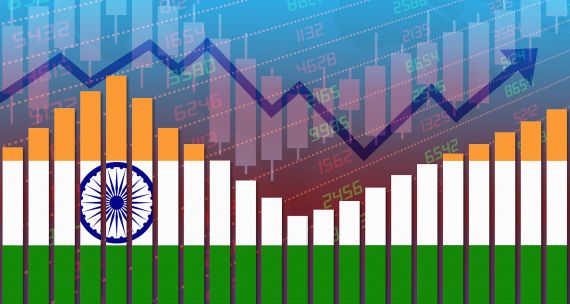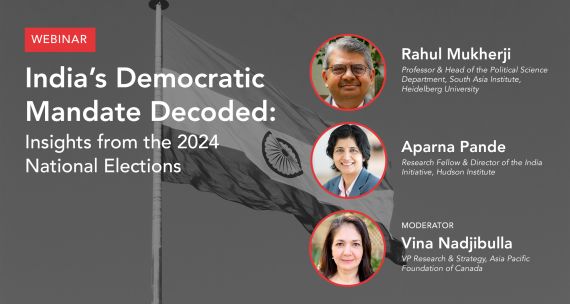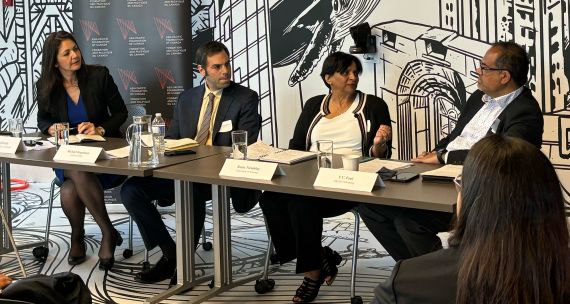With the objective of learning from the rich experiences and lessons that other countries have gained from small- and medium-sized enterprise (SME) export assistance programs, the Asia Pacific Foundation of Canada presents a new research report series, “Going Global.” To read the entire report, please jump to the blue download tab at the end of this piece.
---
India is developing rapidly as a global provider of quality goods and services and as a global business partner. However, international trade is not driven solely by production capacity – it is also influenced by a country’s image. Buyers worldwide appreciate technology and machinery from Germany for its high quality, but also because of their perception of the “Germany brand.” Similar things could be said about food from Italy or fashion from France. Emerging markets such as China and India are struggling with a brand image that is still in the making and results in their products often being perceived as of inferior quality. India has therefore decided to support its export industry (along with the promotion of inbound foreign direct investment) via a vehicle called the India Brand Equity Foundation (IBEF).
IBEF is a joint initiative between India’s Ministry of Commerce and Industry and the Confederation of Indian Industry. Its primary objective is to build a positive image of India globally, to create an international awareness of the “Made in India” tagline in overseas markets, and to provide appropriate information about Indian products and services. IBEF’s website provides information to global investors, buyers, international policy-makers, and world media. In addition to messaging relevant to building a positive brand image, it provides accurate and real-time data on the Indian economy, states, and sectors. It also tracks the latest government announcements on policy, foreign investment, macro-economic indicators, and business trends. IBEF distributes its information with the help of its “India Business Kit,” which comprises various media including e-newsletters, industry reports, CDs, and magazines. It also organizes inbound academic delegations and trips for foreign journalists in order to promote the India brand in general or in particular sectors.
OBJECTIVES OF THE PROGRAM
The primary objective of IBEF is to promote and create international awareness of the Made in India label in overseas markets and to facilitate dissemination of knowledge of Indian products and services. IBEF started out being the branding and communication partner for all The India Show events and trade exhibitions organized under the aegis of the Department of Commerce (administered by the Ministry of Commerce and Industry), and now undertakes a broad range of activities aimed at the promotion of knowledge, communications, and exports.
In its activities, IBEF casts a wide net by serving a rather large number of different industries including agriculture, automobiles, auto components, aviation, banking, biotechnology, cement, consumer markets, education and training, engineering, financial services, food and beverage, gems and jewelry, health care, infrastructure, insurance, IT and IT-enabled services, manufacturing, media and entertainment, oil and gas, pharmaceuticals, real estate, research and development, retail, science and technology, and semi-conductors.
The activities of IBEF are not restricted to specific target markets. IBEF considers itself a resource for companies, organizations, and individuals around the world.
SPECIFIC INTERVENTIONS
IBEF is mainly a content consolidator. For the production of substantial reports, it relies on external partners such as theIdeaWorks for communication design, brand strategy, and public relations, [1] and TechSci Research for in-depth market research. [2] While IBEF was established by the Department of Commerce, IBEF’s board of trustees also includes members from the Ministry of Tourism, the Ministry of External Affairs, universities, and the private sector. The broad representation is designed to ensure far-reaching impact of this initiative, and to steer it into directions that tie in with the efforts of other export and industry promotion initiatives. As such, IBEF has supported a number of trade shows and events, such as the following:
- Fancy Food Show (United States)
- CPhI (worldwide)
- Hannover Messe (Germany)
- Foodex (Japan)
- INNOPROM (Russia)
- JIMEX (Jordan)
In addition, IBEF – in collaboration with the Ministry of Commerce and Industry and the Confederation of Indian Industry – has organized events in a large number of countries around the world (from Slovakia to Nigeria, and from Ghana to Brazil) called “The India Show” at which Indian industries and Indian companies were showcased.
The centrepiece of IBEF’s activity portfolio, however, is information and research. IBEF’s impressive website promotes and supports India’s export industry by providing extensive information on the Indian economy, select industry sectors, companies, activities, and business trends. This includes case studies, e-books, industry reports, trend reports and print publications (available at http://www.ibef.org/research) – all excellent information sources for companies seeking to import from India.
All of the provided materials are open-access, without any registration required. Furthermore, the website also reports on events organized and supported by IBEF and hosts multimedia content such as films. IBEF also publishes a bimonthly business magazine, India Now Business and Economy and a range of thought-leadership studies on emerging areas such as India’s business potential, multinationals, entrepreneurial ecosystem, and contribution to global business.
In recent years, IBEF has also implemented a regular digital communication campaign at the Annual Meeting of the World Economic Forum at Davos, Switzerland, with a view to leverage the opportunity to engage with global business leaders at the Forum. What was originally called “India Adda” at Davos has now become the “Make in India Lounge” and has emerged as a hub for conversations on Brand India and showcasing India’s progressing economy. IBEF is currently also transitioning to sectoral branding initiatives in accordance with the priorities of the Department of Commerce – including pharmaceuticals, engineering, and services.
An interesting future initiative of IBEF’s is the creation and hosting of an export-oriented B2B e-commerce portal similar to China’s Alibaba. The plan is to initially move approximately 100,000 Indian export companies to this portal, and rapidly increase participation to about 500,000. Officials are still working on modalities such as payment mechanisms and insurance, but IBEF has already selected India Post as its partner for the necessary logistics.
OUTCOMES ATTRIBUTABLE TO THE PROGRAM
Detailed information on the usage and success of the initiative could not be identified. However, based on the observation of continuous expansion and development of initiatives under the IBEF umbrella, we find it plausible that the Indian government perceives the mechanism as successful. IBEF and its “Make in India” campaign also receive constant attention by government officials, including Prime Minister Narendra Modi, who recently stated: “I want to tell the people of the whole world: Come, make in India. Come and manufacture in India. Go and sell in any country of the world, but manufacture here. We have skill, talent, discipline and the desire to do something. We want to give the world an opportunity that come make in India.”
APPLICATION TO CANADA
Canada has a very positive image globally that can be leveraged more distinctly in global markets, particularly along dimensions for which there is a natural fit between the country’s national image (e.g. clean nature) and the industry or product category. For instance, Agriculture and Agri-Food Canada has already made small and simple forays into nation branding by suggesting that exporting companies leverage Canada’s positive global image in exporting their products by using brand graphics and photos. This approach could be expanded and used in a more strategic and profound way. Canada could decide to not only focus on sectors that fall within Canada’s perceived brand (such as agricultural products or the energy sector), but it could also decide to focus on lesser-known strengths. These could, for instance, include some of the sectors that have been identified by the Canadian Trade Commissioner Service: [3]
- Aerospace;
- Automotive;
- Biopharmaceuticals;
- Medical devices; and
- Wireless communications.
Another approach would be to focus on one or more of the 230-plus industrial (e.g. the growth clusters of biopharmaceuticals or information and communications technology services) or regional clusters – as identified by Industry Canada’s Cluster Atlas of Canada, for instance. [4] Enhancing Canada’s existing brand image with elements of technology and advanced manufacturing, or, in the case of regional clusters, a well-educated workforce and a deep knowledge base, would assist Canadian companies in their global expansion efforts.
SOURCES
Business Standard (2015). Make in India Lounge to replace India Adda at Davos, http://www.business-standard.com/article/news-ians/make-in-india-lounge-to-replace-india-adda-at-davos-115011401409_1.html.
The Economic Times (2015). Next big thing in India’s e-commerce: Online marketplace for exports based on Alibaba model likely, http://economictimes.indiatimes.com/industry/services/retail/next-big-thing-in-indias-e-commerce-online-marketplace-for-exports-based-on-alibaba-model-likely/articleshow/50165006.cms
Fibre2Fashion (2015). IBEF to build Alibaba like portal in India, http://www.fibre2fashion.com/news/apparel-news/ibef-to-build-alibaba-like-portal-in-india-176401-newsdetails.htm.
Government of India, Ministry of Commerce and Industry, Department of Commerce (eds) (2016). India Brand Equity Foundation, http://commerce.nic.in/DOC/InnerContent.aspx?Id=248.
Huffington Post (2015). India Adda Makes Way For ‘Make in India’ At Davos, http://www.huffingtonpost.in/2015/01/20/make-in-india-davos_n_6512250.html.
India Brand Equity Foundation Facebook Page (2016). https://www.facebook.com/pages/India-Brand-Equity-Foundation/106268446071404.
India Brand Equity Foundation LinkedIn Page (2016). https://www.linkedin.com/in/indiabrandequityfoundation.
India Brand Equity Foundation Website (2016). www.ibef.org.
Spencer, G.M. 2014. Cluster Atlas of Canada: A data profile of resource, manufacturing, and service clusters in Canadian provinces using data from the 2011 Census and National Household Survey. Industry Canada.
Techstory (2015). India To Revamp Its Export Business Through An Ecommerce Portal, http://techstory.in/india-to-revamp-15122015/.
Wikipedia (2016). India Brand Equity Foundation, https://en.wikipedia.org/wiki/India_Brand_Equity_Foundation.
ENDNOTES
[1] http://www.theideaworks.in/index.htm
[2] https://www.techsciresearch.com/about.aspx
[3] http://www.international.gc.ca/investors-investisseurs/sector-secteurs/industrial-industriels.aspx?lang=eng
[4] https://localideas.files.wordpress.com/2014/05/cluster-atlas.pdf
Other reports in our “Going Global” series:
Going Global: Learning from Global Innovative SME Export Assistance Programs
Sector-Specific Initiative: Austria’s Go Silicon Valley
Sector-Specific Initiative: The U.K.’S Cyber Growth Partnership
Market-Targeting Initiative: Israel’s Smart Money Program
Market-Targeting Initiative: Israel’s Indo-China Fund
Management-Focused Initiative: Australia’s Women In Global Business
Management-Focused Initiative: Germany’s Accounting Services
Leveraging People-to-People Connections Initiative: India’s Reverse Visits
Leveraging People-to-People Connections Initiative: The U.K.’s Connectivity Initiatives
Branding-Focused Initiative: India’s Brand Equity Foundation



